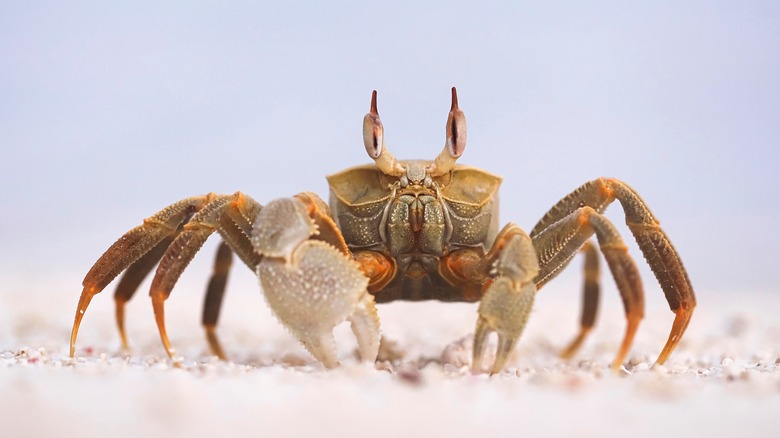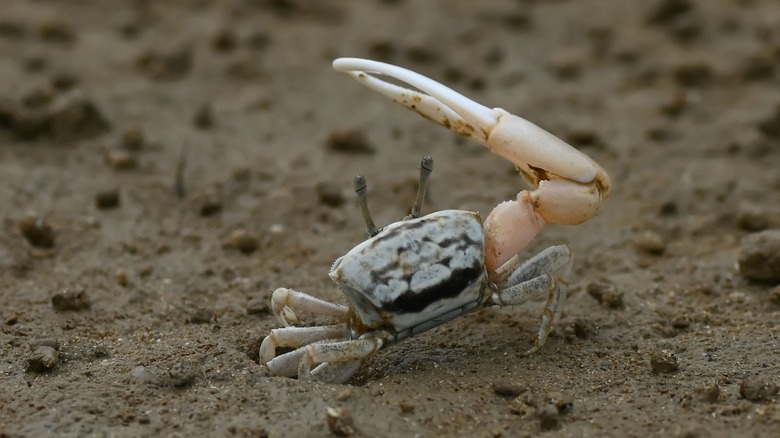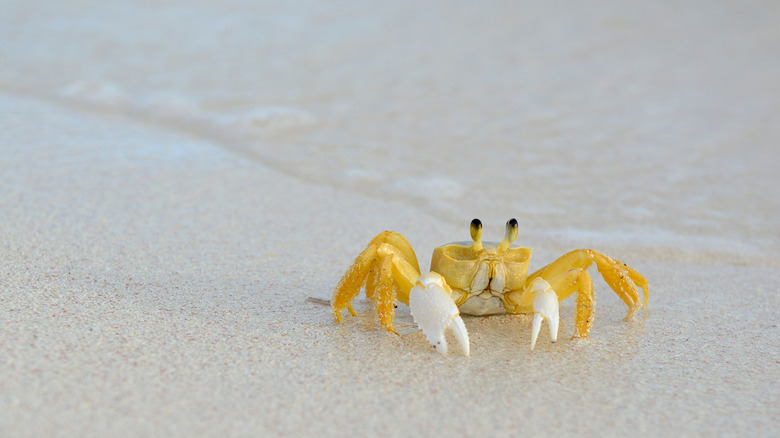Ghost Crabs Ward Off Predators In A Bizarre Yet Terrifying Way
You've heard of vampire bats. Now get ready for ghost crabs. These pale little critters live on beaches across the world, including Chesapeake Bay and the Galapagos Islands (via the Chesapeake Bay Program and Galapagos Conservation). They can't quite phase through solid objects like your standard ghosts might be able to. But they can change colors to blend in with their environment, and they often bury themselves in the sand to hide from predators, meaning, just like the spookiest of ghosts, they can pop out from nowhere at any moment.
Ghost crabs have plenty of unique features. For instance, though ghost crabs are the fastest crab species, they don't move so well in water, according to Galapagos Conservation. They occasionally duck into the waves to wet their gills or lay eggs, according to the Chesapeake Bay Program, but they don't actually swim. Their mating practices are also unique: The male crab's sperm solidifies inside of his partner, making a sort of barrier to fend off the sperm of rivals. But maybe their coolest feature is the teeth in their stomachs, and the grumbling sound they make to ward off predators (via The New Scientist).
The ghost crab's unique defense mechanism
Talk about rumbling in the tummy. To humans, the idea of being able to deliberately make a noise with our stomachs might sound strange. After all, our digestive system can make noises, but they're completely involuntary, and, often, embarrassing.
But crabs, who don't have vocal cords, have had to come up with unique ways to make noise. One method they use is called stridulations, according to The Guardian. This term describes the sounds that crabs make when they rub their claws together. Normally, this sound is something crabs can use as a sort of intimidation tactic against enemies (via The New Scientist).
But in really high-pressure situations, crabs need to have their claws up and ready to fight. It's sort of like the equivalent of not being able to clap your hands together loudly when you're carrying a weapon. So what do crabs do instead? They grind the teeth in their stomach together.
The teeth in a ghost crab's stomach
Ghost crabs have a series of teeth in their stomachs to help digestion, according to The Guardian. Also called gastric mills, these teeth include one larger fang as well as a series of other, smaller teeth. When the crab triggers the gastric mill, these teeth start chewing the bits of food that the crab has eaten to start breaking it down.
Scientists exploring the crabs first discovered that these teeth made noise when they realized the crabs were able to make sounds even when their claws were occupied, per The New Scientist. Following an X-ray, they spotted the teeth grinding around in the stomach. Jennifer Taylor, a biologist who specializes in crabs, told The Guardian that the unique vocalization ability is "definitely an advantage if a predator is up close," adding, "They can pull out their claws and be ready to lunge but still produce these sounds."
These crabs are unique. Both birds and some fish have similar setups, according to The New Scientist, although there are birds that swallow stones to help grind up food, and which make noise. Some fish have teeth in their throats, and those also can make noise and are about as close as anything else gets to the ghost crab's design.


